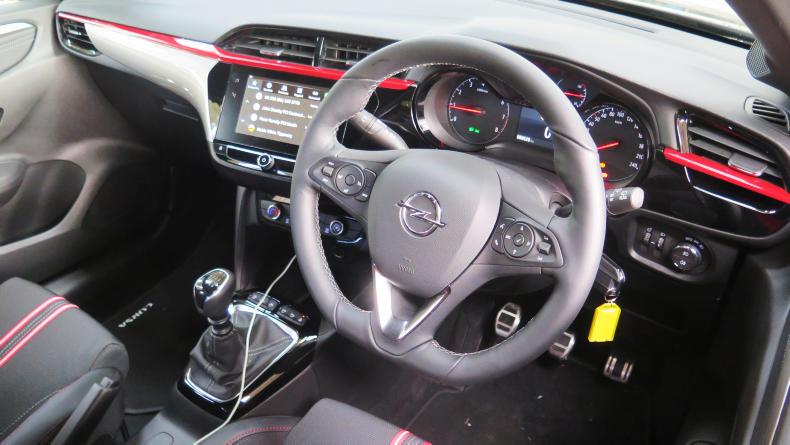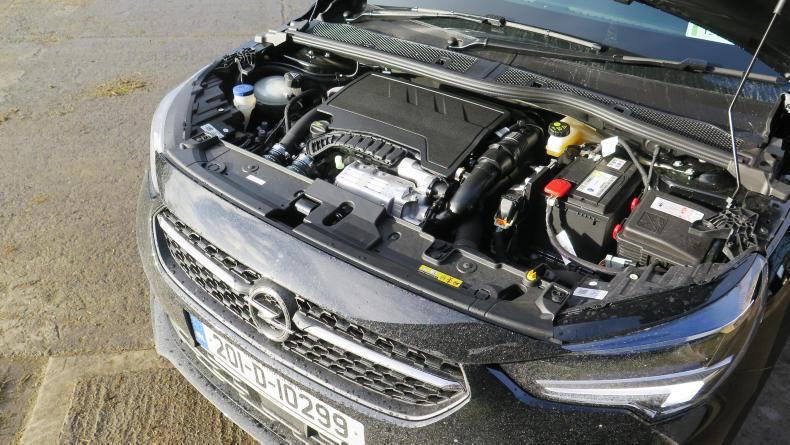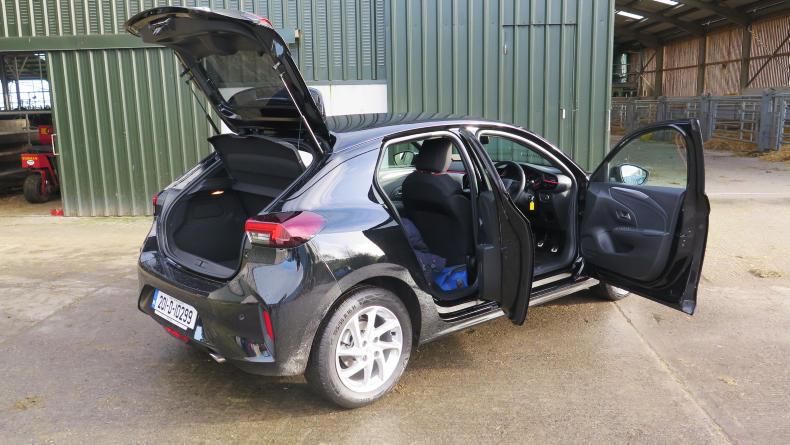Opel has totally upstaged the small car market with a new Corsa that raises the brand’s potential by more than a few notches over its competition. This new Corsa, which just launched in Ireland last month, is impressively different to the car it replaces, both in terms of styling and features. The new model has an overall richer feel to it.
Existing Corsa drivers will instantly get the feel of something different. The layout and design of the dash and the overall touch of the car’s interior features show that this new model has jumped strides ahead, placing Opel’s small car into a new league. The car has gone from being an also-ran to a real competitor for the Ford Fiesta, Toyota Yaris, Renault Clio and Volkswagen Polo, while offering more engine choices than Toyota’s hybrid Yaris.

The dash of the new Opel Corsa is modern and stylish, with a multi-function steering wheel and a large infotainment screen in the centre.
I took the new Corsa for a lengthy overnight test drive and while its three-cylinder turbo-petrol engine whirred at times, it showed power in bundles, making it a lively car to drive. Opel is offering three engine options to start with, made up of two 1.2l three-cylinder petrol versions, one of which is turbo-charged. The third engine option is a thrifty four-cylinder, 1.6l turbo-diesel engine that comes with a €4,000 price premium over the entry level petrol version. Later this year, Opel will offer a full electric version of the new Corsa. Such a range of engine choices means that there is a new Corsa for everyone.
The test car I took to the road was the 1.2l turbo-petrol version, with an impressive 100bhp engine that’s slightly less powerful and lower torque than the diesel choice. The three-cylinder engine is lively with the turbo addition and once on the road, it powers on well and is smooth to drive. The car has impressive acceleration, at 9.9 seconds in a 0 to 100km/hr race.
The six-speed gearbox allowed me to motorway cruise at 120km/hr at just over 2,500rpm. That was enough for me to get a fuel consumption figure of 15.6km/l (6.4l/100km or 44mpg). That’s about 8% over the rated figure and is a good figure to achieve in real driving conditions. The car is over 100kg lighter than the model it replaces and that helps with economy too.

There are three engine options for the new Opel Corsa, and the test car was powered by the new turbo-charged 1.2l three-cylinder engine that delivers 100bhp and 205nm of torque.
This car is competitive with the petrol-powered competition in terms of fuel economy, if not marginally better. The new Corsa is as big as Ford’s new Fiesta and that makes it a sizeable car in its own right. It’s also bigger than the Toyota Yaris with a bigger boot space, and it feels significantly more spacious.
The overall height of the new Corsa has been reduced to deliver better aerodynamics and lower CO2 consumption. Opel claims that there is more front headroom and that the car’s longer wheelbase and increased overall exterior length gives more space and comfort.
The boot volume was increased by 24l to 309l, or up to 1,081l with seats folded. That’s marginally better than the Ford Fiesta boot space when the seats are folded, although the Fiesta has a slight edge with a full complement of passengers.
The new Opel Corsa is available in three trims, SC, SRi and Elite. There are impressive safety features as standard dependent on trim, including forward collision alert with automatic emergency braking and pedestrian detection, radar-based adaptive speed control, lane departure warning and traffic sign recognition.
The new car has a four-star rating in the tougher 2019 Euro NCAP testing programme. That’s marginally lower than the rating for the Audi A1 and the new Renault Clio, both of which achieved a five-star rating. Ford’s Fiesta achieved a five-star rating in its slightly less strenuous 2018 test.
Entry prices for the new Opel Corsa start at €17,975, or £15,750 in N. Ireland. That’s marginally more expensive than the entry-level Toyota Yaris, but significantly cheaper than Ford’s equivalent entry-level Fiesta models.

The new Opel Corsa is longer than before and comes with more leg room, but it’s still a relatively small city car. Boot space is a match for the Ford Fiesta.
There is a big €4,000 jump from petrol to diesel. There is also a big jump in price as you move up the specification ladder, so step up carefully, because you could quickly fall into a €20,000 car if you opt for the turbo petrol or diesel versions. That’s pricey for a small car, even though it’s well improved.
Opel has totally upstaged the small car market with a new Corsa that raises the brand’s potential by more than a few notches over its competition. This new Corsa, which just launched in Ireland last month, is impressively different to the car it replaces, both in terms of styling and features. The new model has an overall richer feel to it.
Existing Corsa drivers will instantly get the feel of something different. The layout and design of the dash and the overall touch of the car’s interior features show that this new model has jumped strides ahead, placing Opel’s small car into a new league. The car has gone from being an also-ran to a real competitor for the Ford Fiesta, Toyota Yaris, Renault Clio and Volkswagen Polo, while offering more engine choices than Toyota’s hybrid Yaris.

The dash of the new Opel Corsa is modern and stylish, with a multi-function steering wheel and a large infotainment screen in the centre.
I took the new Corsa for a lengthy overnight test drive and while its three-cylinder turbo-petrol engine whirred at times, it showed power in bundles, making it a lively car to drive. Opel is offering three engine options to start with, made up of two 1.2l three-cylinder petrol versions, one of which is turbo-charged. The third engine option is a thrifty four-cylinder, 1.6l turbo-diesel engine that comes with a €4,000 price premium over the entry level petrol version. Later this year, Opel will offer a full electric version of the new Corsa. Such a range of engine choices means that there is a new Corsa for everyone.
The test car I took to the road was the 1.2l turbo-petrol version, with an impressive 100bhp engine that’s slightly less powerful and lower torque than the diesel choice. The three-cylinder engine is lively with the turbo addition and once on the road, it powers on well and is smooth to drive. The car has impressive acceleration, at 9.9 seconds in a 0 to 100km/hr race.
The six-speed gearbox allowed me to motorway cruise at 120km/hr at just over 2,500rpm. That was enough for me to get a fuel consumption figure of 15.6km/l (6.4l/100km or 44mpg). That’s about 8% over the rated figure and is a good figure to achieve in real driving conditions. The car is over 100kg lighter than the model it replaces and that helps with economy too.

There are three engine options for the new Opel Corsa, and the test car was powered by the new turbo-charged 1.2l three-cylinder engine that delivers 100bhp and 205nm of torque.
This car is competitive with the petrol-powered competition in terms of fuel economy, if not marginally better. The new Corsa is as big as Ford’s new Fiesta and that makes it a sizeable car in its own right. It’s also bigger than the Toyota Yaris with a bigger boot space, and it feels significantly more spacious.
The overall height of the new Corsa has been reduced to deliver better aerodynamics and lower CO2 consumption. Opel claims that there is more front headroom and that the car’s longer wheelbase and increased overall exterior length gives more space and comfort.
The boot volume was increased by 24l to 309l, or up to 1,081l with seats folded. That’s marginally better than the Ford Fiesta boot space when the seats are folded, although the Fiesta has a slight edge with a full complement of passengers.
The new Opel Corsa is available in three trims, SC, SRi and Elite. There are impressive safety features as standard dependent on trim, including forward collision alert with automatic emergency braking and pedestrian detection, radar-based adaptive speed control, lane departure warning and traffic sign recognition.
The new car has a four-star rating in the tougher 2019 Euro NCAP testing programme. That’s marginally lower than the rating for the Audi A1 and the new Renault Clio, both of which achieved a five-star rating. Ford’s Fiesta achieved a five-star rating in its slightly less strenuous 2018 test.
Entry prices for the new Opel Corsa start at €17,975, or £15,750 in N. Ireland. That’s marginally more expensive than the entry-level Toyota Yaris, but significantly cheaper than Ford’s equivalent entry-level Fiesta models.

The new Opel Corsa is longer than before and comes with more leg room, but it’s still a relatively small city car. Boot space is a match for the Ford Fiesta.
There is a big €4,000 jump from petrol to diesel. There is also a big jump in price as you move up the specification ladder, so step up carefully, because you could quickly fall into a €20,000 car if you opt for the turbo petrol or diesel versions. That’s pricey for a small car, even though it’s well improved.









 This is a subscriber-only article
This is a subscriber-only article









SHARING OPTIONS: